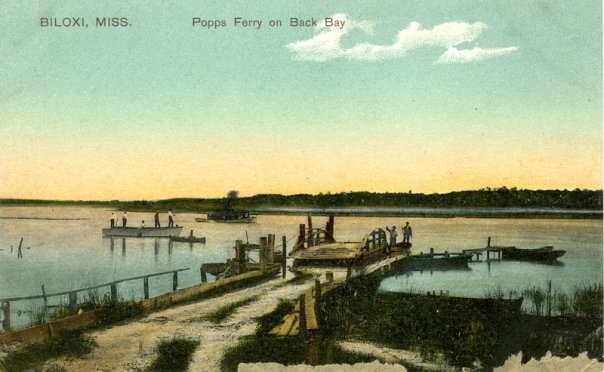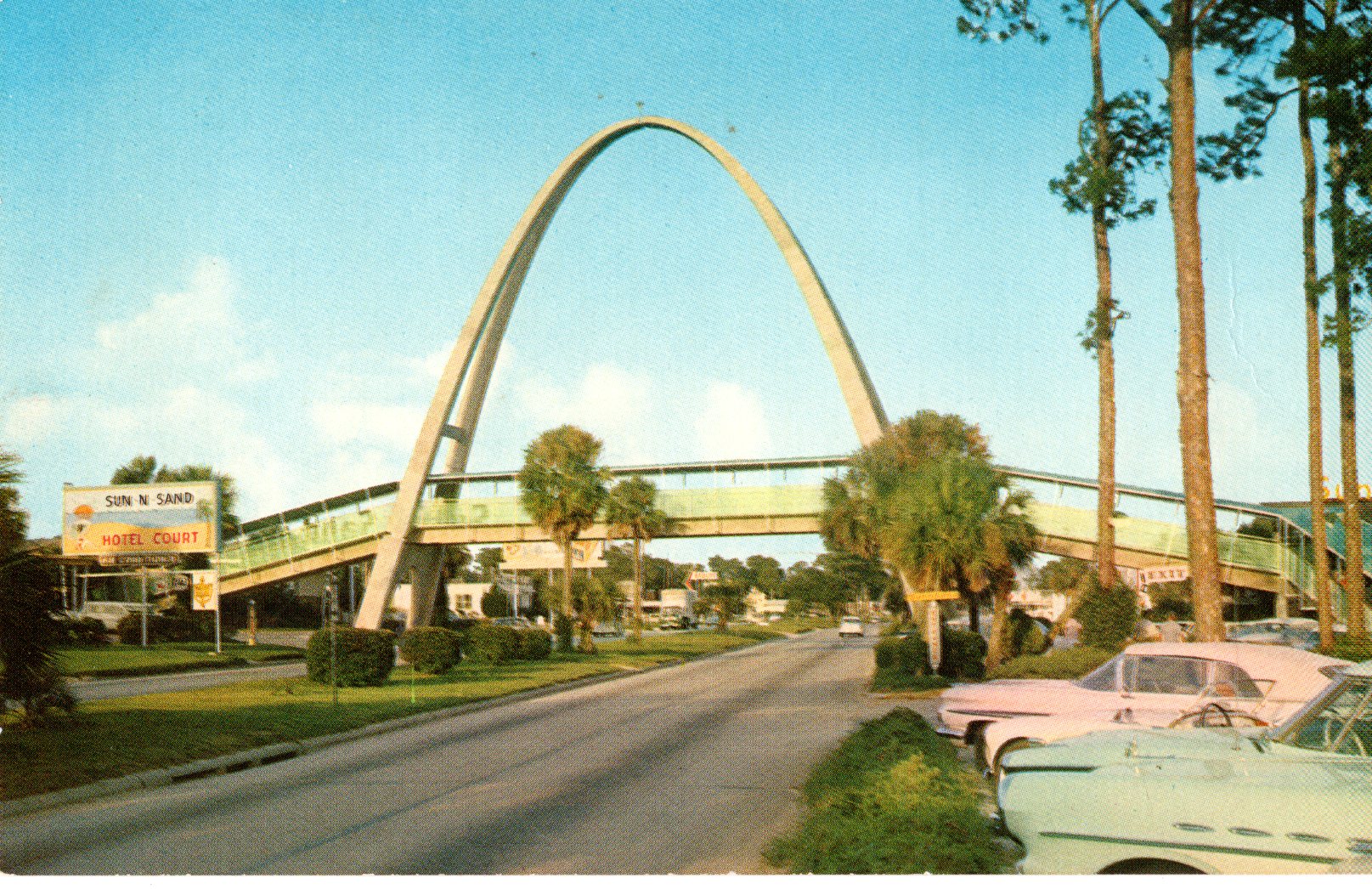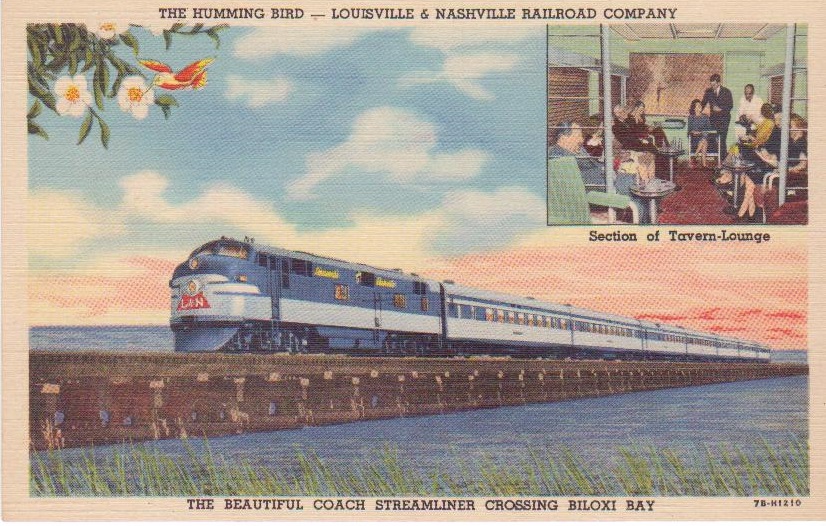Biloxi's Beautiful Bridges
Posted by Jane Shambra on Jun 21st 2023
This article originally written by Jane Shambra with the title "Bridging the Gap" for BNews Monthly, the monthly newsletter of the City of Biloxi. Photographs courtesy of the LHG Image Collection / Local History & Genealogy Department / Harrison County Library System unless otherwise specified.
Whether it’s a planned bridge, a bridge under repair, or traffic issues, bridges certainly have been in the news a lot lately. Biloxi’s history is embedded with a textbook of bridge stories. Here are a few, some you may know and some you may not.

Popp’s Ferry
Before roads and bridges arrived in Biloxi, there were ferry boats. Probably the most memorable ferry was John Popp’s ferry.
Mr. Popp was from Denmark and made his fortune in his lumbering business. Needing a method of transporting his goods, he began his own private ferry service in the late 1800s, which later could be utilized by travelers. Even horses and carriages traveled on his non-motorized ferry.
Mr. Popp’s homestead was the area known today as Sunkist. Upon his death in 1918, The Daily Herald noted the area was called “Popp’s Ferry,” and that the “beautiful part of Harrison County bordering the Tchoutachabouffa River, was also named after Mr. Popp.”
Later came the first Popp’s Ferry Bridge. It was constructed of wood in 1927 and its span was only 700 feet. Its creosoted pine planks were each four inches thick and one foot wide, with three-foot-tall banister railings. Its opening date was in December 1928 at a cost of about $70,000.
Beauvoir and Beachfront Bridges
Traveling south in West Biloxi one comes across Beauvoir Road. Interestingly, locals pronounce this street ”Boo-Vore.” This street is the route which takes us to Hwy. 90 from the Popp’s Ferry bridge and is situated between the Beauvoir property and the Mississippi Coast Coliseum. In the 1800’s, this road was called Dahlgren Road.
Old journals tell us that there was once a little wooden bridge spanning over a brook, which crossed this roadway. Likewise, there was another small wooden structure suspended along Front Road or Hwy. 90 where Oyster Bayou drains into the Mississippi Sound. These roadway features have long ago been replaced by culverts under the road beds.
In the vicinity of Porter Avenue where the Visitors Center Park ravine emptied into the Mississippi Sound, water would often inundate the transportation path. Postcards from the past show us the image of a wooden bridge providing safe passage for those traveling that area.
D’Iberville Bridges
The D’Iberville bridge, which was located off Caillavet Street, was a single-lane wooden structure that was completed in 1901 at a cost of about $17,000.
Interestingly, this bridge had “love seats” built into its structure that could be utilized by both the weary and the romantic pedestrians. This old bridge also had tolls assessed for people, horse and buggies, and cattle. The old wooden bridge was so memorable that in 1926, The Daily Herald newspaper published a poem by Mr. J. B. Allen of Biloxi titled “An Ode to Biloxi’s Old Back Bay Bridge”.
The next bridge constructed in this area was in 1927, it was made of concrete, and cost about $326,000. This bridge, also called the Old Back Bay Bridge, connected Biloxi with North Biloxi. It closed in July 1975 to vehicular traffic but the south section of this old bridge was designated as a recreational fishing pier by the Harrison County Board of Supervisors who were the original custodians of this old bridge.
There were strict rules in place for this re-purposed span: speed limits were now 15 miles per hour and restrictions with penalties were put in place for trash and litter.
According to the Sun Herald, fines for littering dead fish and bait were assessed up to $100, 30 days in jail, or both.
The third bridge constructed in the area off Caillavet Street was the Back Bay Bridge. It opened in June of 1975 and cost about $14,000,000.
It was introduced as part of the new I-110 link for Hwy. 90 and Interstate 10. This span linked downtown Biloxi with the now City of D’Iberville. This part of the interstate highway system was formally named for John C. Stennis and Tony Creel: “The Stennis-Creel Parkway.”
Biloxi Bay Bridges
One of the first bridges to cross the Biloxi Bay to Ocean Springs was the War Memorial Bridge, or what we know today as the Old Biloxi/Ocean Springs Fishing Bridge. It is located off Howard Avenue and was constructed in 1928 for an estimated cost of $900,000.
The bridge, dedicated as a memorial to those who served in World War I, opened to traffic on June 3, 1930 and was celebrated by a parade of fishing boats that dropped wreaths into the water below, much like the Blessing of Fleet tradition. Planes also circled above its 24-foot-wide, 7,768-foot-long span.

Another bridge that was built to cross the Biloxi Bay was erected in 1962 south of the current Point Cadet Plaza for an estimated cost of $7 million. Overall, the bridge was about 1.6 miles long and was designed for a 40-foot clearance over the mean high tide.
At the time, it was the largest bridge designed and built by the State of Mississippi.
In August of 2005, Hurricane Katrina severely damaged the bridge, making it unusable. A new Biloxi Bay Bridge was built, which is the one we have today. The bridge, a 95-foot high, 129-foot-wide, six lane bridge with a 12-foot pedestrian and cyclist path, was dedicated in November 2007. It is designed to withstand hurricane force winds and waves. Let’s hope the bridge is never tested, at least in our lifetimes.
Sun N Sand Pedestrian Bridge
The famous Sun N Sand Motel Hotel was located in Biloxi on Hwy. 90 adjacent to Camellia Street. In 1960, the arch covered walkway was built under the supervision of the Mississippi State High Department. With a 17-foot clearance over the roadbed below, its purpose was to safely connect the north and south sides of its property. This enhancement was a large part of the hotel’s renovation project which also added a “complete dial telephone system in each room.”
The Train Bridge

The Humming Bird train, operated by the Louisville and Nashville railroad company, is remembered for its place in both tourism and transportation on the Gulf Coast. It traveled across the Biloxi Bay on the railroad swing bridge. It was a proud addition to Coast history from 1947 – 1969. With the great news of Amtrak returning to Biloxi, everyone is so excited to be able to one again “ride the rails!”
As we reflect upon our history, we realize that bridges have always been of utmost importance. They enhance the quality of life and the connections with places and people. Even with natural and man-made disasters, Biloxi bridges have proven to be icons of the stamina and resilience of the People of Biloxi.
###
Hungry for shrimp? Visit our Shop page to order wild-caught Gulf shrimp to be shipped to anywhere in the country today!

